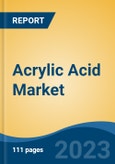Free Webex Call
Global Acrylic Acid Market is projected to grow at an impressive rate through 2028 due to the increasing demand from the construction industry. Building an advanced industrial plant in Manchester costs USD 2,250 per square meterSpeak directly to the analyst to clarify any post sales queries you may have.
10% Free customizationThis report comes with 10% free customization, enabling you to add data that meets your specific business needs.
Acrylic acid is a basic component of chemicals and is derived from propylene. Acrylic acid serves as a precursor for various industrial products, including coatings, adhesives, sealants, dispersants, and thickeners that are utilized in various sectors, including construction, automotive, building, telecommunication, and consumer goods. The commercialization of bio-based acrylic acid would boost the acrylic acid business and fend off government concerns about environmental protection.
Derivatives made from basic renewable materials would reduce our reliance on fossil fuels. The cost of manufacturing acrylic acid would experience a price correction because of the proper balancing of supply and demand because renewable raw derivative types are less expensive than resources derived from fossil fuels. Additionally, bio-based acrylic acid reduces the adverse impacts of acrylic acid on the environment, removing the restriction on utilizing acrylic acid concentrations following regulatory organizations' requirements. This element gives businesses the means to utilize acrylic acid as needed. The market for acrylic acid in places like North America and Europe, where government regulations constrain market development, has a significant growth opportunity due to bio-based acrylic acid. In 2022, the birth rate was 17.668 for every 1,000 people worldwide, which contributed to a lucrative demand for diapers.
Growing Demand for Water Treatment
The treatment of wastewater is a significant issue worldwide. Industries expand along with population growth, posing environmental challenges and health risks. Therefore, it is in the best interests of scientists and engineers to create materials and techniques to reduce environmental pollution. The process of flocculation is crucial to wastewater treatment. The level of treated water quality indicators, a measure of wastewater treatment effectiveness, is reflected by the physical and chemical characteristics of flocculants based on poly (acrylamide-co-acrylic acid) produced by electron beam irradiation.Growing Demand from Construction Industry
Acrylates give polymers various desirable qualities such as clarity, color stability, aging resistance, and heat resistance, in addition to outstanding weather ability, which increases product demand in the paint and adhesives industries. In addition, the glass transition temperature of acrylate ester, which allows the created polymer to be softer and more flexible rather than rigid and brittle, is an important property. Thus, acrylic acid is mostly utilized to create polymers for various plastic goods. Additionally, it can be used to make surfactants, adhesives, and sealants. The acrylic acid market's derivative, application, and geographic segments are separated. Methyl acrylate, butyl acrylate, ethyl acrylate, 2-Ethylhexyl acrylate, glacial acrylic acid, and superabsorbent polymers are the derivatives into which the market is divided.Recent Developments
- In August 2021, BASF and SINOPEC announced plans to expand their Verbund site, managed by BASF-YPC Co. Ltd., a 50% share-owned joint venture of both BASF and SINOPEC in Nanjing, China. The capacity of several downstream chemical plants is being increased, and a new tert-Butyl acrylate factory is being built to meet the rising Chinese market.
Market Segmentation
Global Acrylic Acid market is segmented by derivative type and application. Based on derivative type, the market is divided into Acrylic Esters (Ethyl Acrylate, Methyl Acrylate, Butyl Acrylate, 2-Ethyhexyl Acrylate), Acrylic Polymers (Super Absorbent Polymers, Acrylic Elastomers, Water Treatment Polymers), Ammonium Polyacrylate, Cyanopolyacrylate. Based on application, the market is segmented into surface coatings, adhesives & sealants, diapers, plastic additives, water treatment, thickeners, dispersants, others.Market players
BASF SE, Arkema SA, The Lubrizol Corporation, LG Chem Ltd., NIPPON SHOKUBAI CO., LTD, Evonik Industries AG, Dow Chemical Company, SunVic Chemical Holdings Limited, Hexion Inc., and Shanghai Huayi Acrylic Acid Co. Ltd are some of the key market players.Report Scope:
In this report, Global Acrylic Acid Market has been segmented into the following categories, in addition to the industry trends which have also been detailed below:Acrylic Acid Market, By Derivative Type:
- Acrylic Esters (Ethyl Acrylate, Methyl Acrylate, Butyl Acrylate, 2-Ethyhexyl Acrylate)
- Acrylic Polymers (Super Absorbent Polymers, Acrylic Elastomers, Water Treatment Polymers)
- Ammonium Polyacrylate
- Cyanopolyacrylate
Acrylic Acid Market, By Application Type:
- Surface Coatings
- Adhesives & Sealants
- Diapers
- Plastic Additives
- Water Treatment
- Thickeners
- Dispersants
- Others
Acrylic Acid Market, By Region:
- North America
- United States
- Canada
- Mexico
- Europe
- France
- Germany
- United Kingdom
- Italy
- Spain
- Asia-Pacific
- China
- India
- Japan
- South Korea
- Australia
- South America
- Brazil
- Argentina
- Colombia
- Middle East & Africa
- South Africa
- Saudi Arabia
- UAE
- Turkey
- Egypt
Competitive Landscape
Company Profiles: Detailed analysis of the major companies in Global Acrylic Acid Market.Available Customizations:
With the given market data, the publisher offers customizations according to a company’s specific needs.This product will be delivered within 1-3 business days.
Table of Contents
1. Product Overview
2. Research Methodology
3. Executive Summary
5. Global Acrylic Acid Market Outlook
6. North America Acrylic Acid Market Outlook
7. Europe Acrylic Acid Market Outlook
8. Asia-Pacific Acrylic Acid Market Outlook
9. South America Acrylic Acid Market Outlook
10. Middle East and Africa Acrylic Acid Market Outlook
11. Market Dynamics
12. Market Trends & Developments
13. Porters Five Forces Analysis
14. Competitive Landscape
Companies Mentioned
- BASF SE
- Arkema SA
- The Lubrizol Corporation
- LG Chem Ltd
- NIPPON SHOKUBAI CO., LTD
- Evonik Industries AG
- Dow Chemical Company
- SunVic Chemical Holdings Limited
- Hexion Inc
- Shanghai Huayi Acrylic Acid Co. Ltd








